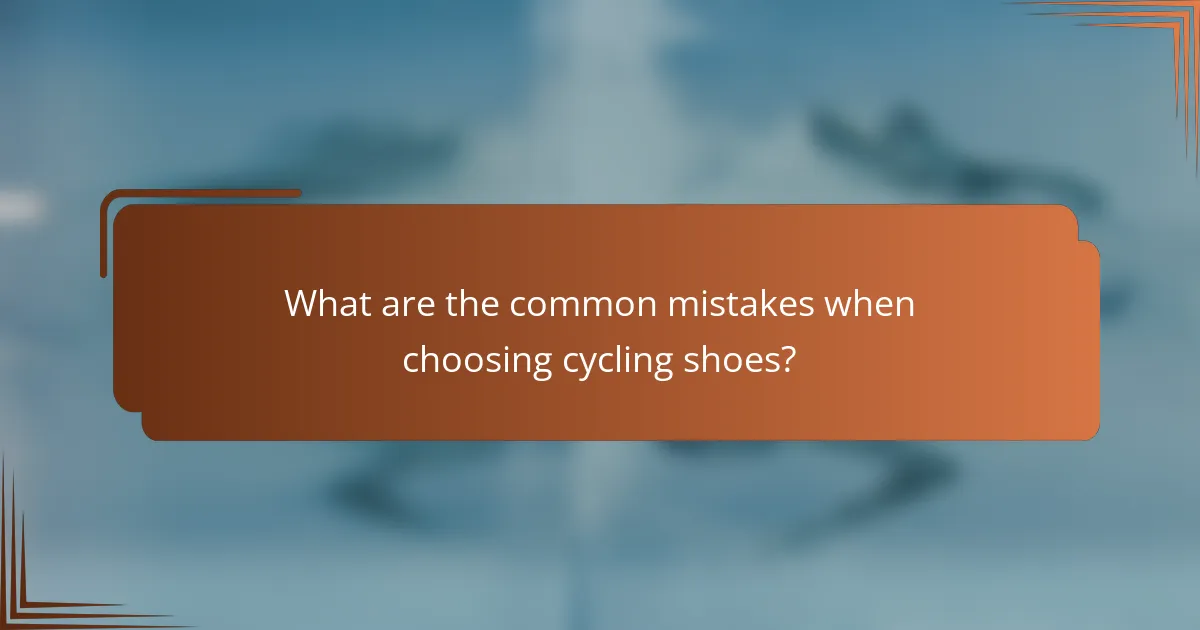Choosing the right high-performance cycling shoes can significantly enhance your efficiency and comfort on the bike. This article explores stiffness ratings, which impact power transfer; the importance of fit for injury prevention; and the various sole types, including carbon and nylon, that cater to different cycling styles. Understanding these elements will help you make an informed decision for optimal performance.

What are the key attributes of high-performance cycling shoes?
High-performance cycling shoes feature key attributes including stiffness ratings, fit, and sole types. Stiffness ratings affect power transfer; higher ratings enhance efficiency. A proper fit ensures comfort and prevents injuries. Sole types vary, with carbon soles providing superior rigidity while nylon offers versatility.
How does stiffness rating affect cycling performance?
Stiffness ratings significantly impact cycling performance by influencing power transfer and comfort. Higher stiffness ratings enhance energy efficiency, allowing cyclists to transmit more force to the pedals. This results in improved acceleration and speed, particularly during competitive riding. However, excessively stiff shoes may reduce comfort, leading to fatigue over long distances. Therefore, finding the right balance between stiffness and fit is crucial for optimal performance.
What factors contribute to the perfect fit?
The perfect fit for high-performance cycling shoes depends on factors like size, width, stiffness ratings, and sole type. A proper size ensures comfort and optimal power transfer. Width accommodates foot shape, preventing discomfort during rides. Stiffness ratings affect energy efficiency; stiffer soles enhance pedaling efficiency but may sacrifice comfort. Sole type influences grip and compatibility with pedal systems, affecting overall performance. Each of these factors contributes uniquely to achieving the ideal fit for cyclists.
Which sole types are most effective for different cycling disciplines?
Stiff soles are most effective for road cycling, while flexible soles suit mountain biking. Different cycling disciplines require specific sole types for optimal performance.
| Cycling Discipline | Sole Type | Effectiveness |
|————————-|—————|————————————————|
| Road Cycling | Stiff | Enhances power transfer and efficiency |
| Mountain Biking | Flexible | Provides comfort and grip on varied terrain |
| Triathlon | Stiff | Facilitates quick transitions and speed |
| Commuting | Moderate | Balances comfort and performance for daily rides|

How do stiffness ratings influence rider efficiency?
Stiffness ratings significantly influence rider efficiency by optimizing power transfer and reducing energy loss. A higher stiffness rating in cycling shoes allows for better energy transfer from the rider’s legs to the pedals, enhancing performance. This is crucial during intense cycling, where every watt counts.
Additionally, the fit of the shoe plays a vital role in overall efficiency. A snug fit, combined with a high stiffness rating, ensures that the rider can maintain optimal pedaling mechanics. For example, shoes with a stiffness rating of 8 or higher often provide the best results for competitive cyclists.
In contrast, shoes with lower stiffness ratings may offer more comfort but can compromise efficiency. Riders seeking to improve their performance should consider both stiffness ratings and fit when selecting high-performance cycling shoes.
What is the relationship between stiffness and power transfer?
Stiffness in high-performance cycling shoes directly enhances power transfer by minimizing energy loss during pedaling. A stiffer sole allows for better energy transfer from the foot to the pedal, improving efficiency. This characteristic is crucial for competitive cyclists seeking optimal performance. Shoes with higher stiffness ratings typically feature advanced materials and construction techniques that support this energy transfer.
How do different materials affect stiffness ratings?
Different materials significantly impact the stiffness ratings of high-performance cycling shoes. Stiffer materials, like carbon fibre, provide better power transfer, while softer materials enhance comfort. For example, nylon soles may offer moderate stiffness, balancing performance and comfort for casual riders. In contrast, full carbon soles maximize stiffness, ideal for competitive cyclists seeking efficiency. The choice of material affects the shoe’s overall performance, fit, and rider experience.

What should you consider when selecting the right fit?
Consider the shoe’s stiffness rating, fit, and sole type for optimal performance. Stiffness affects power transfer; a stiffer shoe enhances efficiency. Ensure a snug fit to avoid discomfort during rides. Choose sole types based on your cycling style; carbon soles offer rigidity, while nylon provides flexibility.
How do foot shape and arch type impact shoe choice?
Foot shape and arch type significantly influence shoe choice for high-performance cycling. A proper fit ensures optimal power transfer and comfort during rides.
Cyclists with flat arches may benefit from shoes with more cushioning and flexibility. In contrast, those with high arches often require stiffer soles for better support. Stiffness ratings in cycling shoes vary, with higher ratings providing less flex, which can enhance efficiency for competitive cyclists.
Additionally, foot shape affects the width and volume of the shoe. Cyclists should consider their foot’s dimensions to select the right fit, as improper sizing can lead to discomfort or injury.
What are the consequences of poor fit on performance?
Poor fit in high-performance cycling shoes can significantly impair performance. It leads to discomfort, reduced power transfer, and increased risk of injury. A proper fit ensures optimal stiffness and sole type alignment with the cyclist’s needs. For example, shoes that are too tight can cause numbness, while loose shoes can lead to instability. Properly fitted shoes enhance efficiency and overall cycling experience.

Which sole types are preferred by competitive cyclists?
Competitive cyclists prefer soles that offer high stiffness ratings, typically carbon fibre or composite materials. These soles enhance power transfer and efficiency during pedaling. Stiff soles minimize energy loss, resulting in better performance. Additionally, a snug fit is crucial to maximize the benefits of these sole types.
How do carbon soles compare to nylon soles?
Carbon soles provide superior stiffness and power transfer compared to nylon soles, enhancing cycling efficiency. Carbon soles are typically lighter and more durable, while nylon soles offer flexibility and comfort, making them suitable for casual riding. The choice depends on performance needs and riding style. Carbon soles excel in competitive environments, whereas nylon soles cater to recreational cyclists.
What role do sole types play in comfort and efficiency?
Sole types significantly impact comfort and efficiency in high-performance cycling shoes. Stiffer soles enhance power transfer, reducing energy loss during pedaling. Softer soles provide more comfort and flexibility, accommodating varied terrains. The optimal choice balances stiffness for efficiency and comfort for longer rides.

How can stiffness ratings differ across brands?
Stiffness ratings can vary significantly across brands due to differences in materials, construction techniques, and design philosophies. Each brand may prioritize different performance attributes, leading to unique stiffness ratings that affect power transfer and comfort. For example, some brands use carbon fibre for maximum stiffness, while others may incorporate flexible elements for enhanced comfort. This variation allows cyclists to choose shoes that align with their riding style and preferences.
Which brands are known for their high stiffness ratings?
Brands known for high stiffness ratings in high-performance cycling shoes include Sidi, Shimano, Giro, Specialized, and Fizik. These brands prioritize stiffness to enhance power transfer and efficiency during cycling. Each brand offers unique technologies and materials that contribute to their stiffness ratings, catering to various rider preferences. For instance, Sidi utilizes carbon fibre soles, while Shimano incorporates composite materials for optimal performance.
What unique features do premium cycling shoes offer?
Premium cycling shoes offer unique features such as advanced stiffness ratings, tailored fit options, and specialized sole types. These attributes enhance power transfer and comfort during rides. Stiffness ratings often range from 6 to 12, indicating varying levels of energy efficiency. Customizable fit options, including adjustable closures and heat-mouldable insoles, ensure a snug experience. Additionally, sole types vary, with carbon soles providing superior rigidity compared to nylon alternatives, which offer more flexibility.

What are the common mistakes when choosing cycling shoes?
Common mistakes when choosing cycling shoes include neglecting fit, ignoring stiffness ratings, and overlooking sole types. A proper fit is crucial for comfort and performance, while stiffness affects power transfer. Additionally, selecting the wrong sole type can impact compatibility with pedals. Prioritize these factors to enhance your cycling experience.
How can improper stiffness selection hinder performance?
Improper stiffness selection can significantly hinder cycling performance by affecting power transfer and comfort. Stiffness influences how efficiently energy is transferred from the rider to the pedals. If shoes are too stiff, they may cause discomfort, leading to fatigue. Conversely, shoes that are too flexible can waste energy, reducing speed and efficiency. The ideal stiffness varies based on individual rider preferences and riding styles, making proper selection crucial for optimal performance.
What are the best practices for ensuring a proper fit?
To ensure a proper fit for high-performance cycling shoes, prioritize accurate measurement of foot length and width. Consider trying shoes on with cycling socks and adjusting for any arch support needs. Pay attention to stiffness ratings, as they influence comfort and power transfer. Test shoes by simulating your cycling position, ensuring no pressure points exist.
Which maintenance tips can prolong the life of cycling shoes?
To prolong the life of cycling shoes, regularly clean them, store them properly, and replace worn components. Cleaning removes dirt and moisture that can degrade materials. Store shoes in a cool, dry place to prevent mould and shape distortion. Regularly replace insoles and outsoles to maintain performance and comfort.